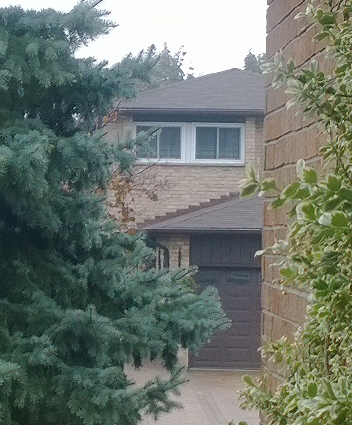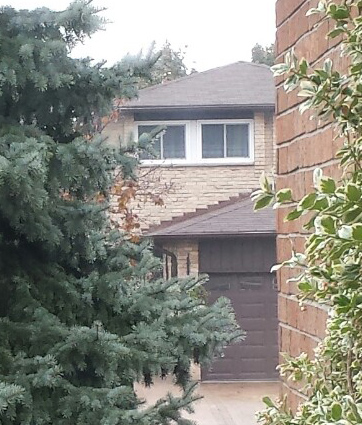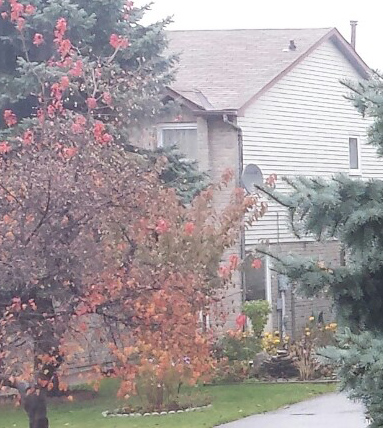| Review of the Nokia Lumia 1020 |
 |
The Lumia 1020 is the current top-of-the-line Windows Phone 8 device from Nokia. It's claim-to-fame is a 41-megapixel camera. Last Updated: 09-Nov-2013 |
Before reading this review,
please read Some Thoughts on Phone Reviewing.
Letís face it, the real reason I tested this phone was to try out the camera.
The lure of a 41-megapixel camera was just too great. Now I canít speak for most
people who might get the Lumia 1020, but I strongly suspect that the camera will
be at the top of their list of reasons for buying it. For that reason the bulk
of this review will be devoted to the camera, though I do touch on most of the
other hallmarks of my phone reviews.
RF Performance
The Lumia 1020 I borrowed was on Telus, and so I was unable to make RF
comparisons between it and my Samsung Galaxy S4. However, my old
Samsung Galaxy S2 LTE, which I
unlocked and gave to my wife to use on a Telus prepaid service, was available
for comparison. If you look back at my review of the
Galaxy S4 youíll see that I compared its
RF performance against that of the GS2 and I declared it a tie. Because of this,
we can assume that the GS2 is an acceptable stand-in for the GS4 in this test.
After finding a suitable spot in Square One where the Telus signal was
sufficiently weakened (many of my favorite test spots are presently closed off
to the public due to mall expansion), I performed test calls. Surprisingly the
Lumia 1020 did markedly better than the GS2, and I say surprisingly because it
is rare that I find this much of a difference in RF performance between one
phone and next in modern smartphones. Itís probably a result of excellent
antenna design on the part of Nokia, but regardless of what it is the Lumia 1020
is has superb RF characteristics (in HSPA mode at any rate).
Audio Performance
In-call audio is rather odd, in that it appears to be enhanced to try and bring
out the sibilance in spoken words (this refers to high-frequency components, in
particular the ďsĒ sounds). The enhancement works, insomuch as it does highlight
those nuances of speech, but in doing so it sounds rather artificial. Iíve never
encountered a phone before that has this peculiar feature, including other Lumia
models.
The above-mentions enhancement notwithstanding, the native earpiece has a
reasonably nice tone and volume is acceptable. However, it isnít as loud as the
SG4, particularly if you activate the volume boost feature on the Samsung phone
during a call.
The speakerphone is a huge disappointment. It just doesnít have anywhere near
enough volume to be all that useful, except in very quiet environments. The GS4
is markedly louder under normal circumstances, but when the volume boost is
activated the Samsung phone totally blows the Lumia 1020 out of the water when
it comes to speakerphone volume. Clarity is about the same however.
Multimedia Audio
The Lumia 1020 has a single multimedia speaker located behind a grill at the
bottom edge of the phone (next to the USB connector). I compared the Lumia 1020
to the GS4 using YouTube and various music apps. Both phones provide
approximately the same maximum volume, though the Lumia 1020 sounds a bit muddy
compared to the GS4. Depending upon what you are listening to the muddiness
either makes it sound a bit fuller or it makes it sound distinctly duller. The
difference between the Lumia 1020 and GS4 is only slight, but compared to the
stellar sound of the speakers on the HTC One neither phone sounds exactly great.
Display
The Lumia 1020 comes with a 1280 x 768 Super AMOLED display. While youíd have
expected a high-end model like the Lumia 1020 to have a 1920 x 1080 screen like
the GS4, this canít currently be accommodated in Windows Phone 8. Nokia was
therefore restricted to this resolution, but Iíve noted before that 1080p
screens are somewhat overkill and itís unlikely youíll find anything to complain
about with the resolution of the screen.
However, given that the outside width and height of the Lumia 1020 arenít much
different from that of the GS4, itís rather disappointing to find that you get
only a 4.5-inch screen, compared to the 5-inch screen on the GS4. In fact, the
smaller screen looks almost comical on the Lumia 1020, which has a wide bezel
around it and lots of unused space at the bottom.
Because they use pretty much the same display technology, both the Lumia 1020
and the GS4 have approximately the same maximum screen brightness, though the
Lumia 1020 has a slightly yellowish tint to it. However, youíll only notice this
tint when comparing it with other phones, because the human brain does a
terrific job of white-balancing the world around it. This is why we donít think
a room looks red under incandescent lighting and green under fluorescent
lighting. It is possible to SLIGHTLY change the color balance and saturation of
the screen, but the amount you can alter it is slight and no amount of
adjustment gets ride of the yellow tint.
Camera
Well, this is the feature that got the lionís share of my attention. And with
good reason, because the Lumia 1020 has what should be a simply incredible
camera. I started with rather elevated expectations of the cameraís
capabilities, but I found myself a little let down in the end by its inability
to hold up to those high standards. Donít get me wrong though, this is probably
one of the best camera sensors ever put in a smartphone, but if you thought it
would trounce the competition in all aspects of photography, youíre in for a bit
of a surprise.
As it comes out of the box there are no less than 3 Nokia-specific camera apps
(along with the stock Windows Phone 8 camera which you will most likely never
use). You were forced to pick the one that had the features you wanted, and that
was a royal pain. However, an update from the app store changed that by
installing a new all-encompassing app called Nokia Camera. However, the other
two apps (called Nokia Smart Cam and Nokia Panorama) still exist. It seems that
the new camera app just calls these other apps to access their functionality.
Itís an ergonomic improvement, but it didnít overcome some of the severe
limitations of the 3 independent apps.
The main camera app has some very well-implemented manual adjustment features
laid out in an excellent U/I. It is the only camera app that will natively save
a high-resolution version of the picture, along side the down-sized 5 megapixel
version that you get out of all the other apps. However, if you thought those
pictures would be 41 megapixels, you were slightly misled.
In the default 16:9 aspect ratio the images are 7712 x 4352, which is a grand
total of 33,562,624 pixels. When the 4:3 aspect ratio is used the pictures are
7136 x 5360, which is 38,248,960 pixels. If youíre wondering where they got the
41-megapixel figure from, then take a closer look at those dimensions. The
sensor is 7712 pixels wide (as used in 16:9 pictures) by 5360 pixels tall (as
used in 4:3 pictures). If we multiple those figures we get a total of
41,336,320. So, the sensor really does have 41 million pixels, but you canít use
them all at once.
The Nokia Camera app has those wonderful manual controls, as well as the
standard auto-focus, auto-white balance, and auto exposure settings, but it
doesnít do some of the more interesting things weíve come to expect from
cameras, such as Best Shot, Action Shot, Motion Focus, Change Faces, or Remove
Moving Objects. To get them the Nokia Camera app defers to the Nokia Smart
Camera, but sadly it does not save a high-resolution version of the picture and
all you get is a down-sized 5 megapixel image. To its credit however, it stores
all of the information it gathers in a large file that it can reference later.
This makes it possible to repeatedly generate new composite images using any of
the special features.
Now, if you want to take a panorama you are deferred Nokia Panorama. This
single-minded app has no customizations and you can only use it horizontally.
Despite the massive sensor it has to work with, the resulting pictures are only
1,656 pixels high. Compare that with the GS4, which when used vertically to take
a panorama results in pictures that are 3,072 pixels high.
As for ergonomics, this is the weirdest panorama feature Iíve every used. Just
about every other one on the market today simply requires you to pan smoothly
around and wait for the results. In this one you must move the phone to the next
photo position as indicated on the screen. If you move a bit too fast it looses
your position and requests that you return to the previous position and try
again. Thereís no denying that the results are good, but getting them is a bit
of a pest.
There doesnít seem to be an HDR mode in any of the camera apps. Until recently I
didnít put much stock in this feature, chiefly because the one provided on my
dedicated Sony Cybershot camera wasnít all that great. However, after seeing how
incredibly effective the HDR mode is on the GS4 Iíve since changed my mind, and
its absence here is a big strike against the Lumia 1020 as a camera substitute.
What the camera app lacks in features however, it makes up for in low-light
capability. The sensor will go up to ISO 4000, which is far higher than is
typical on most camera phones. Usually we donít see more than ISO 800 (though
the GS4 does go up to ISO 1000, but only when set to it automatically). The
Lumia 1020 is also capable of much longer exposures (you can manually set it as
long at 4 seconds). Iíve never seen anything longer than 1/17th of a second on
the GS4. The optical stabilization of the lens makes longer exposure times
possible without the risk of a horrendously blurry shot.
All of that wouldnít be of much use if the sensor was noisy at low light levels
and long exposures, but itís actually pretty clean. The grain is acceptable and
the camera software doesnít try to over-sharpen the resulting image. The camera
has the ability to shoot in incredibly dim light and produce results that are
quite spectacular. The only issue I had with them was that they were a bit too
red or a bit too yellow and needed to be color-corrected after the fact. Many
people will not bother to do this, so the color balance on many low-light photos
taken with the Lumia 1020 will be a little off.
Okay, but what about the quality of pictures taken in good lighting conditions?
I started out by assuming that due to the 41-megapixel sensor theyíd be
spectacular too, but the pictures didnít quite live up to my expectations. It
started once again with the color balance, though this time around the pictures
were usually too green and lacked enough red. This could be corrected in
Photoshop, but again I doubt that many people would do this.
When photographing complex sunlit pictures, such as the vegetation in my
backyard, the Lumia 1020 just couldnít seem to sharply focus on or cleanly
render the tiny leaves and countless details the way my GS4 could. To be certain
it wasnít just a result of camera shake I put the phone on a tripod (using a
tripod mount for smartphones). I then used the timer to take the picture so that
I wasnít handling the phone at the time. However, with optical image
stabilization such precautions shouldnít have been necessary, especially when
the GS4 was used handheld and it hasnít got optical image stabilization. The
issue therefore was not movement of the camera during the shot.
No matter what I did (including the cleaning of the lens opening and ensuring I
set the focus to the object I wanted to be the center of my examination) the
shots kept coming out the same way. There was no question that in brightly-lit
situations (typically any outdoor shot taken during the day, either in sunny or
overcast conditions) the GS4 produced slightly sharper-looking shots despite
having only a 13-megapixel sensor going up against the 41-megapixel sensor of
the Lumia 1020. When I shrunk the GS4 photos down to 5 megapixels (in-phone
using the photo editor of QuickPic) and I compared them to the downsized 5
megapixel images from the Lumia 1020, the same was still true and the GS4 shots
looked sharper, better saturated, with better overall contrast.
Iíve included a couple of cropped samples from the 5-megapixel versions of
pictures taken with both phones so that you can at least see what Iím talking
about. On occasion I managed to take outdoor pictures with the Lumia 1020 that
matched the GS4. This may suggest the Lumia has a problem with its auto-focus
algorithms that donít accurately set the focus each time. This at least suggests
that it can be fixed in later releases of the camera software.
 |
 |
| Lumia 102 | Galaxy S4 |
At least part of the problem
seems to be the quality of the lens. The GS4 retains sharp images all the way to
the edges of the picture, while the Lumia 1020 looses a bit of its sharpness
around the edges. This might be the result of production variation in the
grinding of the lens (that is, I might have ended up with a really good lens on
my GS4 and a rather poor one on the Lumia 1020). Far off twigs that have lost
their leaves made an excellent source of material for this type of testing.
Iíve included two sets of crops taken from the 5-megapixel versions of the
picture from both cameras. The first set of crops show the center of the view to
demonstrate that the Lumia 1020 was indeed in focus and not blurry. The second
set is cropped from the left sides of the same photographs. Even in the center
crop you can see that the GS4 does a much better of job of picking the exposure
and it renders cleaner details and greater contrast. I should not that this is
an extreme example of this effect, presented here only to give you an idea of
what Iím referring to.
 |
 |
| Center of the 1020 Photo | Center of the GS4 Photo |
 |
 |
| Left edge of the 1020 photo | Left edge of the GS4 photo |
Video functionality is pretty
basic. You can start and stop videos and thatís pretty much it. Unlike the GS4
you canít PAUSE a video and restart it. You cannot change the focus during the
shooting of a video (and essentially switch to manual focus) as you can in the
GS4, meaning you must rely on the auto-focus not to mess with you. As far as I
can tell you cannot take full-resolution stills during the shooting of a video
either, though I might have missed that. One final niggle about the videos is
that the wider angle of the lens on this phone produces accentuated fisheye-like
distortions as the camera is panned.
One thing that does make the videos markedly better than on most phones is the
optical image stabilization. This feature works especially well when you zoom
in. During a zoom even slight movement of the phone results in very noticeable
changes in the image. Most other phones (including the GS4) rely on digital
stabilization in which the processing of the resulting image is manipulated to
reduce the appearance of jiggles. In optical stabilization the lens if
physically moved to keep the image stable as it falls on the sensor. And
speaking of zoom, you can do a lot more of it while still retaining true 1080p
resolution due to the high number of pixels in the sensor. The same is true of
the GS4ís 13 megapixel sensor, but not as much so.
Youíd think that the excellent low-light sensitivity in stills would translate
into really good low-light videos. Youíd be wrong. In fact, the GS4 has slightly
better low-light sensitivity in video mode than the Lumia 1020 does. This is
probably because of the way in which the sensor achieves its amazing low-light
sensitivity in stills canít it be utilized at 30 frames per second. The HTC One
on the other hand has excellent low-light sensitivity when shooting videos,
which is probably a testament to the lower-resolution sensor that phone uses.
The bottom line is that the sensor in the Lumia 1020 truly is the best one out
there when it comes to low-light photography. In fact, many of the low-light
shots were ever better than I could take with my Sony Cybershot camera. However,
once thereís sufficient light the GS4 matches and often exceeds the quality of
the Lumia 1020, especially in color balance and certain types of image detail.
This sounds quite similar to what I found with the HTC One. It seems that when a
sensor is optimized for excellent low-light performance, it suffers when it has
to work in bright light.
Conclusions
My feelings toward Windows Phone devices have been stated many times before. I
find them severely limited and despite their smooth overall performance I can
never bring myself to use one on a regular basis, because they just frustrate
the hell out of me. Even when well-known apps are available for Windows Phone,
they are often pale imitations of their Android or iOS counterparts.
Was the camera on the Lumia 1020 spectacular in all aspects, then it might be
possible to own one to use just as a camera. However, it isnít yet good enough
to replace a mid-range point-and-shoot, and so thereís little chance Iíd do
that.
This isnít to say that Windows Phone isnít right-on-the-money for some people,
and if you happen to be one of those types and you were looking for an excuse to
spend the extra money on the Lumia 1020, then the camera performance is
certainly good enough to make it worth your while. For the rest of us however,
we can be somewhat jealous of certain aspects of the cameraís performance, while
at the same time feel smug in the knowledge that our choice of a non-Microsoft
O/S will more than make up for it.